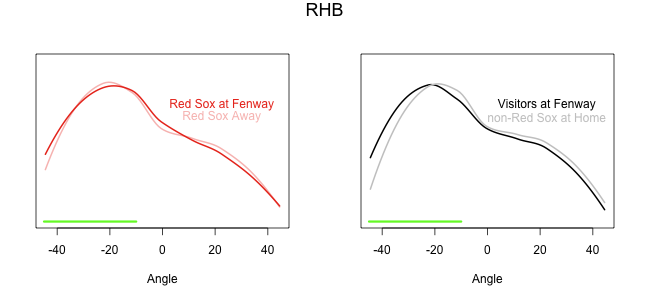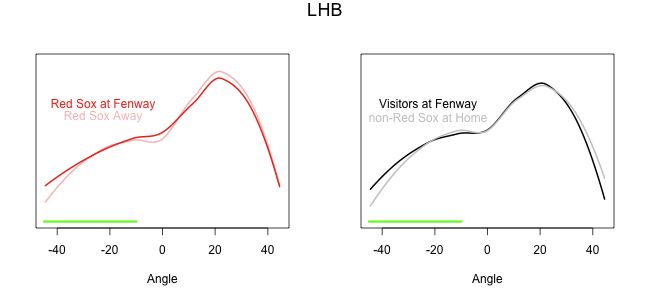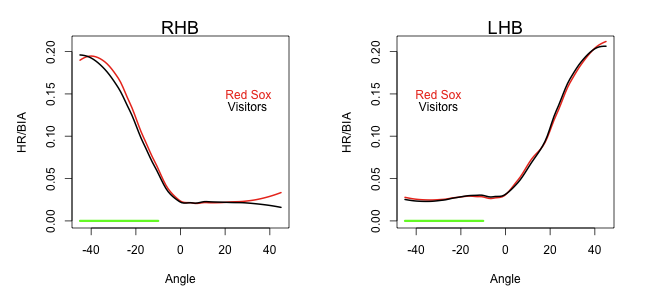
| F/X Visualizations | June 26, 2009 |
Two months ago when Sky was looking at predicting home field advantage based on ballpark qualities he determined that a 'quirky' ballpark generally had a larger home field advantage than a non-quirky one. I thought that was a very interesting result and wanted to try to see it for a specific example. Obvisouly the most famous quirky feature in any ball park is the Green Monster at Fenway Park.
Maybe Red Sox hitters are better able to take advantage of the Green Monster, thereby giving Fenway a larger home field advantage because of its quirky dimensions. Like much of my work this is heavily indebted to earlier work on the subject by John Walsh. In early 2007 he looked at which Red Sox hitters take the most advantage of the Green Monster and also which non-Red Sox would benefit most by hitting at Fenway.
Percent of balls in air towards Green Monster
If Red Sox do take advantage of the green monster than you would expect them to hit more balls in its direction, with RHBs trying to pull more balls and LHBs trying to go the other away with more when they are home than when they are away.
Here is the frequency distribution of the angle of fly balls and line dives to the outfield by RHBs . The plot on the left is for Red Sox hitters when home and away, and on the right for all visitors at Fenway and all non-Red Sox teams when they are at home. I use the same -45 (3B line), 0 (2nd base), 45 (1st base) orientation for my last post. The Green Monster is indicated in green.

It looks like visitors at Fenway change their approach much more than Red Sox hitters. Red Sox hitters' home and away spray patterns are virtually indistinguishable, but for visitors the spray pattern is shifted a degree or two toward third base when batting at Fenway. I assume this is caused by these hitters trying to pull the ball more, but it could also be a result of Red Sox pitching (maybe they pound the inside of the zone more than the average pitcher).
Here is the same figure for left handed batters.

Both Red Sox and visiting lefties hit slightly more balls in play down the left field line at Fenway than elsewhere. Going along with that is a slight drop in the number of pulled balls in play at Fenway for both groups. The effect is subtle, but it looks like lefties might make some effort to go the other way more often at Fenway.
Here is an overview.
Proportion of outfield fly balls and line drives in direction of the Monster +---------------------+--------+--------+ | | RHB | LHB | +---------------------+--------+--------+ | Red Sox at Fenway | 0.503 | 0.266 | | Red Sox Away | 0.511 | 0.257 | | Visitors at Fenway | 0.507 | 0.287 | | Non-Red Sox at Home | 0.477 | 0.278 | +---------------------+--------+--------+
Here you can see that Red Sox righties actually hit fewer balls in play in the direction of the Monster at Fenway than on the road. That is very surprising. Visiting RHBs see a big jump in their balls in play to that direction. For both Red Sox and visiting lefties there is a small increase in balls in play to that direction at Fenway compared to elsewhere.
Percent that actually hit monster
Ok so visiting hitters are hitting more balls in play towards the Green Monster, but are they actually getting more hits off it? I used the same technique as John Walsh and classified a ball in play as one off the monster if it was a fly ball or line drive that was a hit and fielded within 25 feet of the Monster (I am using the gameday batted ball locations with Peter Jensen's translation factors). When John went back and checked this he found that about 60% of the 'hits off the monster' were really that, so these numbers will be over estimates. But I don't think they will systematically over or under estimate Red Sox compared visitors.
Using such a definition here are the percentage of batted balls that I classified as 'hits off the monster.'
Proportion of balls in play that are hits fielded within 25 ft of the Monster +---------------------+--------+--------+--------+ | | RHB | LHB | All | +---------------------+--------+--------+--------+ | Red Sox at Fenway | 0.054 | 0.037 | 0.046 | | Visitors at Fenway | 0.060 | 0.041 | 0.052 | +---------------------+--------+--------+--------+
These numbers seem very high, so I am sure that I am overestimating the number of Monster hits by quite a bit. Still it seems that visitors, both lefties and righties, get more hits off the Green Monster than Red Sox hitters. This seems very counter intuitive. If these hits would have been outs elsewhere the Green Monster is giving visitors an advantage. On the other hand if visitors are changing their approach at the plate to get more hits off the Monster maybe their contact to other areas is weaker.
Home Runs Over the Monster
The other thing the Green Monster offers is a short, but high, porch to hit HRs over. If Red Sox hitters can adapt their swings to hit more HRs over it, that could be where the advantage shows up. Here is the HR rate per ball in the air by angle, just in Fenway.

Now here is a big advantage to Red Sox hitters. Over the length of the Green Monster Red Sox righties have a big HR/BIA advantage over visitors. In the rest of the field, expect for just along the right-foul line, there is little difference in HR-rate. Does it look to you like Red Sox righties tailor their swings to getting HRs over the Green Monster?
The next step would be to put it all together. How much do the additional HRs by Red Sox hitters weigh against the additional hits off the Monster by visitors? Could we calculate the value of the Monster to the Red Sox in such a calculation? Maybe another day.
Comments
I Appreciate this analysis being a Red Sox fan. Mike Lowell seems to benefit most from Fenway. It seems like he just looks middle in all the time and tries to pull the ball. Which is fine, because he doesn't have much power to the opposite field anyway.
Posted by: Joe at June 26, 2009 5:20 AM
Very interesting study. Given the conclusions about HR/BIA, I wonder how valid it is to assume that just looking at balls fielded within 25 feet of the Monster doesn't systematically over or under estimate Red Sox compared visitors. The home run data indicates that RHB Sox hitters are producing a different kind of contact towards the Monster than their visitor counterparts. Perhaps the Sox hitters have a better feel for which pitches when pulled will make it off/over the Monster instead of flying out to left. We might also add into the mix the fact that the Sox pitching staff is used to dealing with righties that might be trying to pull the ball more often than usual. I'm not trying to say that either of these are necessarily the case, just that I'm not sure we should accept the conclusion that Sox batted balls fielded within 25 feet of the Monster look the same as those hit by visitors. I imagine it would be a pain in the neck to gather the kind of data needed to investigate this point, though...
Posted by: bootymfg at June 26, 2009 11:13 AM
One other thing that might be considered is that Red Sox management may try to obtain players whose swings would most benefit from the monster. I know when JD Drew was signed a lot was made about Drew hitting 4 or 5 more homers a year on fly balls the opposite way that would have been outs elsewhere. I don't believe this actually happened, but that doesn't rule out that management makes this a consideration when acquiring free agents.
Posted by: Conor at June 28, 2009 10:04 PM